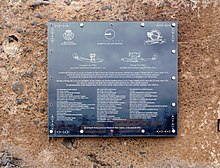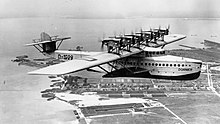Dornier Do X
| Dornier Do X | |
|---|---|
 The Dornier Do X 1930 on Lake Constance |
|
| Type: | Airliner |
| Design country: | |
| Manufacturer: | Dornier works |
| First flight: | July 12, 1929 |
| Commissioning: | October 1930 |
| Production time: |
1928 to 1931 |
| Number of pieces: | 3 |

The Do X was a commercial airship that was designed by the German Dornier works after the First World War and built in 1929. It was financed by the AG für Dornier-Flugzeug , a corporation founded by the Weimar Republic / German Reich . In its day it was by far the largest airplane in the world. The mission was discontinued by the new rulers in Germany in 1933 due to various security-related problems that still existed and due to insufficient economic viability, but also due to insufficient military suitability. There were still two aircraft for export toItaly built. The planned successor model, the Dornier Do 20 , was not implemented due to the start of the Second World War .
construction
The Do X was a stripped shoulder -wing wing built as a flying boat with a tail unit in a standard arrangement and twelve piston engines , which were mounted in six tandem gondolas above the wing. Each nacelle had a pull and a push propeller . The cockpit was on a deck above the passenger cabin. The aircraft was designed for 159 passengers and 10 crew members.
story
Claude Dornier drew the first sketches for this aircraft in September 1924, but the planning was not completed until December 1926. The construction time of the first Do X was 240,000 working hours or 570 days. The first flight of the aircraft took place on July 12, 1929 in Altenrhein, Switzerland on Lake Constance . Initially planned only as a taxiing exercise to test maneuvering behavior, the first few meters of free flight came after chief in-flight pilot Richard Wagner - probably out of curiosity - pulled the wheel a little too hard while gliding at full throttle.
But the professional world remained skeptical. Claude Dornier therefore decided on a spectacular demonstration flight. On October 21, 1929, the Do X undertook a sightseeing flight of 53 minutes over Lake Constance with ten crew members and 159 passengers (factory employees and their families), although the machine was not yet approved for passenger flights. The number of passengers represented a record that was only broken 20 years later with the appearance of the Lockheed Constellation (168 passengers and 11 crew members).
It was not until October 1930 that the aircraft was accepted by the German Aviation Research Institute and given the aircraft registration number D-1929.
The choice of engine was also problematic. The most powerful engine from German production available at the time was the Siemens Jupiter , a license built by the British Bristol Jupiter with 385 kW (525 hp ). The motors did not meet the requirements of continuous operation in the Do X. The air-cooled engines tended to lose performance over longer periods of time. Higher continuous speeds as compensation were not possible due to the threat of overheating. The problem could only be finally solved by exchanging the engines for the American Curtiss-Conqueror engines with water cooling and 470 kW (640 hp). In order to market the Do X successfully, Dornier decided to go on a global representation flight, during which he wanted to demonstrate the comfort and safety of his machine to the world public . The luxurious interior of the flight ship is documented today in black and white photos and color illustrations by the marine painter Claus Bergen . The representative flight started on November 5, 1930. Amsterdam was chosen as the first destination of the trip, followed by England , France and Portugal . Due to a fire that could just be fought, there was a two-month stay to repair the building. The journey continued to Gran Canaria (January 31, 1931), along the West African coast to Portuguese Guinea , to cross the Atlantic there at its narrowest point, then to Rio de Janeiro (June 20, 1931), then the South American one Following the coast to the Caribbean and finally to the USA near Miami on August 22, 1931 . On August 27, 1931, the airship reached New York City , where it was received with great cheers and the crew received an audience in the White House with President Herbert Clark Hoover . After the aircraft had been wintered at Glenn Curtiss Airfield until April 1932, it was given a similar reception on May 24, 1932 in Berlin , where it landed on Lake Müggelsee and anchored near the Rübezahl restaurant .
The crew during the USA flight included navigation officer Wilhelm Niemann as first officer and first flight ship postmaster . He was responsible for the Dornier Do X auxiliary post office on board the airship and the DO-X mail processed there . The commandant of the Do X was Friedrich Christiansen . On the five-day return flight of the Do X from New York to Berlin from May 20, 1932, the aviator Antonie Straßmann was part of the crew.
During the subsequent flight to Germany, which began in Stettin on June 23, 1932 , over a million people visited the Thu X, famous for its “two-year world flight”. The five-month flight to Germany concluded on November 2, 1932 on Lake Zurich . On November 14, 1932, the machine returned to its "birthplace" in Altenrhein.
incident

On May 9, 1933, the plane was supposed to land on the reservoir of the Passau Kachlet power plant in order to make a planned stop there on another round trip along the Danube in the direction of Turkey. However, the flight captain Horst Merz started the landing too steeply and the tail unit broke off. This breakdown was initially concealed from the public, but a spectator happened to take pictures. Although the damage from this accident was repaired, it meant the end of her career as a passenger aircraft for the Do X. This was announced by the Reich Aviation Ministry in October 1934 .
Do X2 and X3
The fate of the two Do X2 " Umberto Maddalena " and Do X3 "Alessandro Guidoni" delivered to Italy was unknown for a long time. The two machines were ordered in 1931 for the Italian Società Anonima Navigazione Aerea (SANA), where they were to be used in Mediterranean traffic along the Italian west coast from Genoa to Tripoli. However, this planned use was not implemented. Instead of the Curtiss engines, both machines were fitted with Fiat engines with only around 440 kW (600 hp). After crossing the Alps, they were used by the Italian armed forces from the flying boat base in La Spezia-Cadimare for training flights at the Higher War School. A use as a bomber was tested, for this purpose they were given a glazed rear stand. The military organized some sightseeing flights in Italy to increase the public's acceptance of the relatively high and controversial expenses for the two machines. The Do X2 was decommissioned in 1935 after a third accident. Both aircraft were scrapped in 1937 (although the X3 was never damaged), probably because of technically and economically unacceptable expense.
Whereabouts

The Do X (D-1929) was dismantled in Travemünde in 1933 , shipped to Berlin and finally exhibited there in the German Aviation Collection Berlin on the ULAP site at Lehrter Bahnhof , a forerunner of the German Museum of Technology in Berlin . It was damaged in a bomb attack in November 1943 during World War II , and then largely destroyed by metal dealers and collectors immediately after the war. Today only a few pieces of metal can be seen in the German Museum of Technology in Berlin.
A wooden propeller can be viewed in the Friesian Museum on the island of Föhr . The commander Friedrich Christiansen came from the island and the Do X stopped here before her flight to America in 1931.
The tail unit, which was demolished in Passau in 1933, can be viewed in the Dornier Museum in Friedrichshafen.
At the Swiss Altenrhein airfield, where the DO-X was built, an airworthy, true-to-original model on a scale of 1: 8 with a wingspan of six meters can be seen in the Aviation Museum there. It was built and demonstrated for the International Bodensee Airshow 1998 (IBAS '98) by the local model flight clubs.
Technical specifications
| Parameter | Dates of the Do X 1a |
|---|---|
| crew | 10-14 |
| Passengers | 166 |
| length | 40.10 m |
| height | 10.10 m |
| span | 48 m |
| Main wing wing area | 450 m² |
| Wing area auxiliary wing | 30.80 m² (only for Siemens motors) |
| Empty mass | 28,250 kg |
| max | 52,000 kg |
| Top speed | 210 km / h |
| Cruising speed | 175 km / h |
| Landing speed | 120 km / h |
| Fuel capacity | 23,300 l |
| Range | 1700 km (normal) 2300 km (maximum) |
| Climb performance | 1000 m in 14 min |
| Summit height | 3200 m |
| Engines | 12 V-12-cylinder engines Curtiss V-1570 Conqueror each with 470 kW (640 PS) total output 5640 kW (7680 PS) |
criticism
Due to accidents such as “fire on board” and “tail unit torn down”, the Do X was not considered to be sufficiently safe. Both the motorization and the tail unit, which is low compared to today's flying boats, were causes. The Lufthansa introduced the Do-X operating one due to economic considerations. The two copies delivered to Italy were taken out of service after a short time due to unresolved problems. The follow-up project Dornier Do 20 was not implemented.
The "Dornier Do X" project opened up a new dimension in aircraft construction at that time, the technical and economic inadequacies of which would have been eliminated with the follow-up project (if it would have been politically possible). As a prototype without a role model, the Do X was of course not yet economically viable. There were hardly any “teething troubles”. The main reason for discontinuing the program was political. The secret rearmament program of the Weimar Republic, from which the Do X was financed, had become known through the Lohmann affair and the emerging Nazi state saw no military use in the aircraft, so that the above-mentioned reasons were mainly put forward.
Trivia
The flying boat plays a role in the Karl Hartl film " FP 1 does not answer " from 1932, which thus supplements the rather sparse film material about the Do X.
See also
- List of aircraft types
- Boeing 314
- Dornier Do 20 and Dornier Do 214 (follow-up projects)
- Altenrhein (Do X tugboat)
literature
- Volker A. Behr: Dornier Do X. Motorbuch Verlag, Stuttgart 2011, ISBN 978-3-613-03329-0 .
- Claude Dornier : From my engineering career. Self-published, Zug 1966, (private print).
- Jörg-Michael Hormann : Dornier. Plant history and types of aircraft . 2nd revised edition. Delius Klasing, Bielefeld 2009, ISBN 978-3-7688-2610-5 .
- Jörg-Michael Hormann: Airship DO-X. The Chronicle. Delius Klasing, Bielefeld 2006, ISBN 3-7688-1841-1 .
- Jörg-Michael Hormann: A ship flies into the world. 75 years of the Dornier flying ship Do X D-1929. Deutsche Post AG, Bonn 2004, ISBN 3-00-014367-X .
- Brigitte Katzwandel-Drews: Claude Dornier. Aviation pioneer. Klasing, Bielefeld 2007, ISBN 978-3-7688-1970-1 .
- Peter Pletschacher: Large aircraft Dornier Do X. Authentic photo documentation of the world's first large aircraft, 1929. 3rd edition. Aviatic-Verlag, Oberhaching 1997, ISBN 3-925505-38-5 (also contains information on Do X2 and Do X3).
- Fritz Strauss: On a dangerous flight. An adventurous study flight which, in addition to exciting experiences, offers a number of scientific explanations that arouse interest in these areas. Loewe, Stuttgart 1932.
- Jörg-Michael Hormann: Why ships had to fly. Start of transatlantic air traffic . In: Schiff Classic. Magazin für Schifffahrts- und Marinegeschichte , vol. 1, 2013, pp. 48–55.
- Dornier GmbH Friedrichshafen Dep. PR, 799 Friedrichshafen Do X 1929 / With the first flying ship Dornier Do XD 1929 over three continents Anniversary publication; Double book volume from January 1979.
- Do X - the largest flying ship in the world . 73 pictures, introduced by Claudius Dornier , explained by Erich Tilgenkamp. Schaubücher 41. Zurich: Orell Füssli, 1931
Web links
- General
- Dornier Do X. In: History of powered flight. EADS Deutschland GmbH, October 16, 2009, accessed on August 29, 2009 .
- Do-X-Aerophilatelie - Airmail, catalog, on -board postmark
- Travel reports, interiors, data
- Stereoscopic postcards
- Landing of the Do X in New York, August 31, 1931 ( Memento from September 30, 2007 in the Internet Archive ) (requires RealPlayer)
- Aviation history - megalomania to the power of X one day
- About the accident on the Kachlet reservoir
- A flying giant visits the Chiemsee . In: Traunsteiner Tagblatt
- Beginning of the end of the first "jumbo" . (PDF) In: Starnberger Merkur , 17/18. May 2008
- Marton Szigeti: Dornier Do X: Legendary Flying Boat. Flug Revue, June 1999, p. 16 , archived from the original on September 10, 2004 ; accessed on September 23, 2004 .
- A flight aboard the DoX - 1930 on YouTube Various historical recordings of the Dornier DoX , 3 min. 2 sec.
- Historical recordings of the Dornier Do X on YouTube , 5 min. 14 sec.
Individual evidence
- ↑ Beginning of the end of the first "Jumbo" . ( Memento of the original from January 2, 2016 in the Internet Archive ) Info: The archive link was inserted automatically and has not yet been checked. Please check the original and archive link according to the instructions and then remove this notice. (PDF) In: Starnberger Merkur , 17/18. May 2008
- ↑ Do X inspires New Yorkers . In: FliegerRevue , August 2011, pp. 50–53









